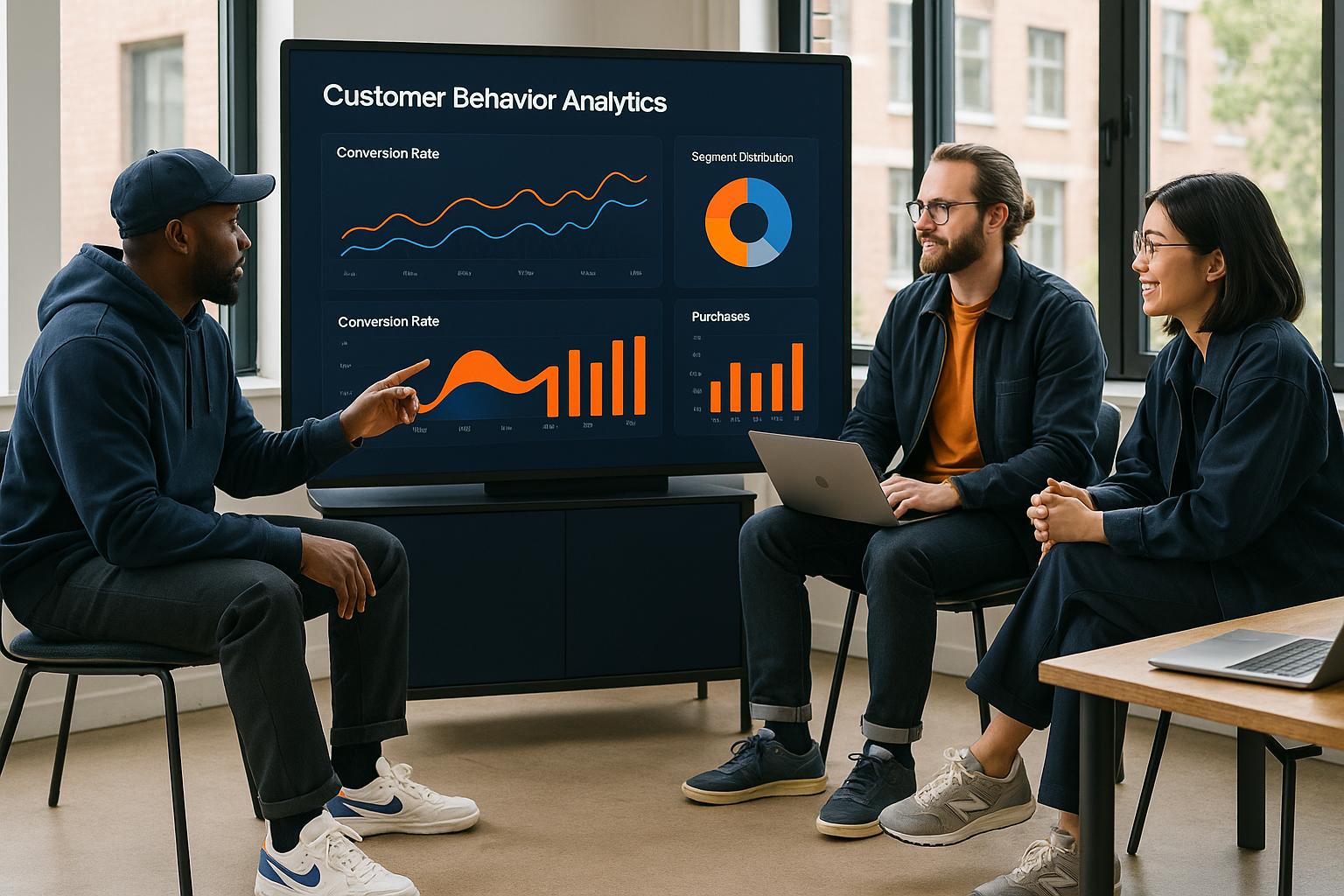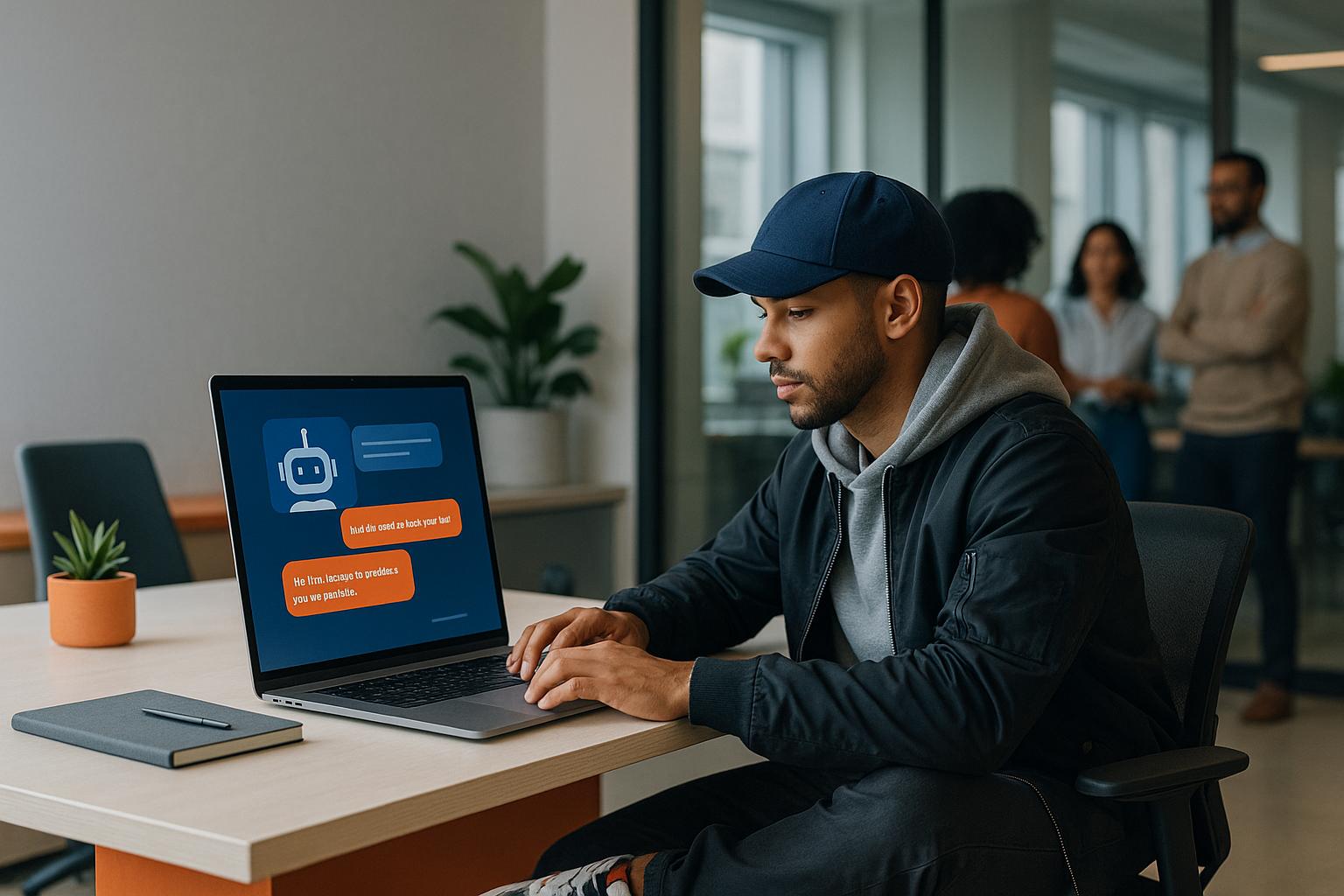AI video personalization is changing the way businesses engage with customers. By creating tailored video content using customer data like preferences, behaviors, and demographics, brands can deliver highly relevant messages that resonate with individuals. This approach leads to better engagement, higher conversion rates, and stronger customer retention.
Key Takeaways:
- Engagement Boost: Personalized videos increase click-through rates by 16x and improve viewer retention.
- Higher Conversions: AI-driven campaigns can raise conversion rates by up to 20%.
- Retention Gains: Personalized experiences strengthen loyalty, with a 5% retention increase boosting profits by 25%-95%.
- Scalability: AI automates video production, saving time and reducing costs by 23%.
For example, the San Antonio Spurs used AI to create custom welcome videos, achieving a 35% rise in email clicks and a 100% video completion rate. Similarly, Amazon’s personalized Prime Day videos in India significantly improved shopper engagement. Businesses that integrate AI-powered personalization see measurable improvements in marketing ROI, sales, and customer loyalty.
AI video personalization isn’t just a trend – it’s a proven way to connect with audiences meaningfully while optimizing resources.
Revolutionizing Marketing with Scalable AI-Generated Personalized Videos
How AI Powers Video Personalization
AI is revolutionizing video marketing by using vast amounts of customer data to craft personalized video experiences. Through advanced algorithms, it delivers content that feels tailored to each viewer. Behind the scenes, AI analyzes data, predicts preferences, and ensures the content connects with individual interests.
How AI Analyzes Customer Data
AI dives deep into customer behavior, examining browsing history, purchase habits, content preferences, and demographics to build detailed profiles. It starts with audience segmentation, grouping users by shared traits and behaviors to uncover patterns that might otherwise go unnoticed. For instance, it might reveal that people shopping for outdoor gear on weekends respond better to adventure-themed videos, while weekday shoppers prefer practical product demonstrations.
AI also identifies hidden trends and predicts future actions. For example, a cat owner who recently bought pet supplies might be shown a video promoting discounted cat toys, while a dog owner without recent purchases could see a video offering a higher discount on dog products. With every interaction, the system refines its recommendations, making them increasingly precise.
"AI personalization refers to the use of artificial intelligence (AI) to tailor messaging, product recommendations and services to individual users. By analyzing data and learning from user behavior, AI-powered tools can create highly personalized encounters that enhance customer experiences and increase customer engagement."
– Molly Hayes, Content Writer, IBM Consulting
This data-driven approach sets the stage for the tools that convert insights into dynamic, engaging video content.
Key Technologies Behind AI Personalization
AI video personalization relies on technologies like machine learning, predictive analytics, and dynamic content generation.
- Machine learning algorithms are the backbone of AI personalization. These systems analyze massive datasets, including images, videos, and text, to create content that resonates with viewers.
- Predictive analytics uses user data – such as browsing habits and purchase patterns – to anticipate preferences and forecast future behavior.
- Dynamic content generation allows AI to adapt video content in real time based on factors like viewer location, demographics, or behavior.
Major platforms like Netflix, Amazon, Spotify, and YouTube use these technologies to deliver personalized recommendations and content . New advancements, like text-to-video generation, are taking personalization to the next level by enabling quick, scalable production of tailored video content.
Scalability and Efficiency of AI Solutions
AI excels at scaling personalization to meet the demands of massive audiences. Unlike traditional methods, which struggle with high volumes, AI automates repetitive tasks like scriptwriting, editing, and video customization. This automation not only saves time but also reduces production costs by an average of 23%. AI-powered interactive videos have been shown to increase conversion rates by 24%, making them a game-changer for marketers.
AI can also produce multiple versions of videos optimized for different platforms, further enhancing efficiency. Real-time analytics provide instant insights into viewer engagement and retention, allowing marketers to fine-tune strategies on the fly.
A standout example is Lay’s "Messi Messages" campaign from 2021. Using Synthesia’s AI technology, Lay’s created personalized video messages featuring a synthetic Lionel Messi. After filming Messi for just a few minutes on a green screen, Synthesia’s algorithms generated a synthetic avatar that delivered messages in eight languages. The campaign offered over 650 million video variations, produced 1.43 million messages in two days, and achieved a 12.8% bounce rate, with fans staying engaged for an average of 3.53 minutes per visit.
To handle growing video demands, AI-powered Enterprise Video Content Management systems offer scalable storage and processing capabilities. As the generative AI market is projected to hit $1.3 trillion by 2032 with a 42% CAGR, and digital video ads are expected to account for nearly 60% of all U.S. TV and video ad spending by 2025, the need for scalable AI solutions is clear.
Businesses leveraging AI-driven personalization see stronger brand loyalty, increased customer engagement, and improved sales. Studies show AI can enhance marketing effectiveness by 30% and boost sales by 20%. These benefits highlight why investing in AI-powered video personalization is a smart move for companies looking to stand out in a competitive market.
Proven Benefits of AI Video Personalization
AI video personalization brings measurable results that traditional video marketing methods simply can’t achieve. It not only grabs attention but also turns that attention into tangible outcomes, addressing the engagement challenges marketers often face.
Better Engagement Metrics
By leveraging advanced AI analytics, personalized video strategies deliver a noticeable boost in engagement. Instead of generic messaging, these videos include personalized touches like the viewer’s name, tailored product suggestions, or content aligned with their specific interests.
The numbers speak for themselves: businesses using personalized videos report an average 16x increase in click-through rates and a 4.5x rise in unique click rates. Additionally, 78% of viewers stick around for the first 20 seconds of videos that use variable data.
Nike’s campaigns are a great example of this. By using data like purchase history and workout preferences, Nike achieved a 20% higher open rate on personalized emails and a 30% increase in click-through rates. On top of that, viewers were 25% more likely to take recommended actions.
AI also enables interactive features like clickable links, custom calls-to-action, and tailored recommendations, creating multiple opportunities for engagement. For instance, videos in email campaigns increase sharing rates by 50%, and personalized calls-to-action result in 202% higher conversions compared to generic ones. Even non-profits see results: Breast Cancer Now’s Twitter campaign saw nearly 80% of viewers liking the personalized video, with almost half retweeting it and a reach of 77,000 users.
Higher Conversion Rates
Personalized videos don’t just engage – they convert. These videos can boost conversion rates by up to 20%, with some applications, like those by Idomoo, reporting as much as a 9x increase in conversions.
Take HubSpot, for example. Their use of personalized video messaging resulted in a 40% higher conversion rate for leads and a 30% jump in meeting bookings. This success stems from AI’s ability to analyze customer behavior and deliver highly relevant, individualized experiences.
On average, marketers see a 20% rise in sales with personalized campaigns, while AI-driven personalization can improve conversion rates by 15–20%.
"We believe that personalized video will command increasingly larger portions of advertising and marketing budgets due to its ROI improvement over traditional video content and other outbound methods of communication."
– Jim Nail, Forrester
These improved conversions naturally pave the way for stronger customer loyalty.
Better Customer Retention
One of the most impactful long-term benefits of AI video personalization is its ability to improve customer retention. A modest 5% increase in retention can lead to profit growth of 25% to 95%. Personalized videos create emotional and mental connections that static content simply can’t match. Viewers retain 95% of information from videos compared to just 10% from text.
Seventy-two percent of consumers respond better to personalized messages, and one financial services company saw 68% completion rates for personalized onboarding videos, compared to just 15% for standard ones. These interactive videos create memorable experiences that not only resonate personally but also strengthen emotional ties and brand advocacy. For example, interactive videos have been shown to boost product usage and repurchase rates by over 30%.
MPL’s re-engagement campaign with Studio by Gan.AI is another success story. Their personalized videos offering rewards increased completion rates from 9% with non-personalized content to 46%, while conversions rose fivefold.
Beyond individual campaigns, AI-powered recommendations and messaging enhance overall customer satisfaction and engagement, leading to greater loyalty and word-of-mouth referrals. When customers feel understood and valued through personalized experiences, they’re far more likely to stick around and advocate for the brand.
sbb-itb-d6d4d8b
How to Implement AI Video Personalization
Bringing AI video personalization into your business doesn’t have to be overwhelming. By focusing on the right tools, data, and strategies, you can gradually weave these capabilities into your existing workflows. The process starts with solid data foundations, selecting the right platforms, and using smart segmentation techniques. From there, businesses can use analytics, dynamic content, and precise targeting to boost engagement.
Using AI-Powered Analytics Platforms
The backbone of effective AI video personalization lies in choosing the right analytics platform. These platforms help track, analyze, and optimize video performance. In fact, over 75% of marketers already use AI tools in some capacity. This makes selecting the right platform a critical decision.
When evaluating options, look for tools that align with your goals and integrate seamlessly with your current marketing systems. Prioritize platforms that offer customization and real-time analytics to uncover patterns and trends quickly. Such platforms allow you to adjust your content based on how viewers interact with it, making your videos more effective.
Additionally, some platforms support advanced features like AI avatars, text-to-video tools, and detailed editing capabilities. Whether you’re looking to create simple personalized videos or highly tailored campaigns, finding a platform that meets your technical and creative needs is key.
Dynamic Video Content Creation
Once you’ve got analytics in place, dynamic video creation is the next step. This approach uses data to craft content that adapts to viewer preferences in real time. For instance, AI text-to-video tools enable businesses to generate videos by simply describing a scene, with the AI handling everything from visuals to lighting and movement. This makes it possible to create multiple video variations for different audience segments without needing a full production team.
Platforms like Canva and Adobe Firefly simplify this process, letting marketers produce customized videos quickly. To make the most of dynamic content, businesses should implement predictive analytics – AI algorithms that anticipate viewer behavior based on past data. These algorithms allow videos to automatically adjust messaging, visuals, or calls-to-action, ensuring that each viewer gets a tailored experience.
However, none of this works without clean, up-to-date data. Establishing strong data governance practices is essential to ensure your AI tools have accurate information to work with. Without it, even the most advanced tools will fall short.
AI-Driven Audience Segmentation
Audience segmentation is the cornerstone of personalized video campaigns. By dividing your audience into specific groups, you can deliver content that truly resonates. Research shows that 71% of consumers expect personalized content from companies.
AI takes segmentation to the next level by analyzing factors like purchasing habits, browsing history, and even sentiment. This deeper understanding helps businesses predict behavior and tailor their messaging. For example:
- Amazon uses dynamic segmentation to recommend products based on past purchases and browsing activity, driving higher sales.
- Wells Fargo utilizes AI to create targeted communication strategies that address individual customer needs.
- Coca-Cola and Nike both leverage AI to segment their audiences, tailoring campaigns to specific lifestyle preferences and regional trends.
The most advanced form of this is predictive segmentation, which forecasts future behavior to anticipate customer needs. This allows businesses to craft video content that feels intuitive and relevant, even before customers voice their preferences.
To succeed, combine AI-driven insights with human expertise. Marketing and data teams should work together to interpret AI findings and apply them strategically. This collaboration ensures your campaigns are not only data-driven but also aligned with real-world customer expectations. Companies that embrace personalization effectively can see 40% more revenue growth than those that lag behind.
Conclusion: The Potential of AI Video Personalization
AI video personalization is reshaping the way businesses connect with their audiences. By turning generic marketing efforts into tailored experiences that align with individual preferences and behaviors, this technology meets the rising expectations of today’s consumers. Companies embracing this shift are positioning themselves to outpace competitors and achieve measurable improvements across key marketing metrics.
How AI Enhances Engagement
The impact of AI-driven video personalization on engagement is undeniable. Marketers leveraging this approach consistently see engagement rates double, leading to stronger ROI and deeper customer loyalty.
The financial benefits are equally striking. Marketers using AI personalization report a 25% boost in marketing ROI, while companies adopting AI-driven personalization experience an average sales increase of around 20%. These results stem from AI’s ability to deliver the right message at the perfect moment.
Retention is another area where AI shines. According to Gartner, AI-driven personalization reduces churn by 28%, while also cutting customer acquisition costs by up to 50%. When customers receive content that resonates with their needs and interests, their connection to the brand strengthens, fostering long-term loyalty.
AI also simplifies the video production process, saving both time and money. By automating technical tasks, teams can focus on broader strategies and creative vision. These advancements not only enhance current marketing efforts but also set the stage for future innovations.
The Future of AI in Marketing
AI’s role in marketing is poised to grow even further. By 2030, the global AI market is expected to exceed $1.5 trillion, with 79% of CEOs predicting generative AI will drive efficiencies. This level of investment signals that AI-powered personalization is becoming the norm rather than a novelty.
Looking ahead, AI is set to transform customer engagement in ways we’re only beginning to imagine. For instance, future applications like VR and AR will create immersive, interactive video experiences. These technologies promise to redefine how brands connect with their audiences, moving beyond traditional video content to entirely new forms of interaction.
Real-time hyper-personalization is emerging as the next big leap. AI now enables brands to communicate with millions of customers as if each interaction were individually tailored. This ability to combine personalization with scale is revolutionizing how businesses approach their marketing strategies.
"Your job will not be taken by AI. It will be taken by a person who knows how to use AI." – Christina Inge
This quote underscores a crucial truth: the real advantage lies not in AI itself, but in how effectively teams integrate it into their workflows. 52% of CEOs believe AI will unlock new growth opportunities, but achieving these results requires thoughtful investment in education and implementation.
Success in this evolving landscape will come to those who see AI video personalization as more than just a technical tool. It’s a way to fundamentally rethink and strengthen customer relationships. With 72% of consumers engaging only with marketing content that feels relevant, mastering AI video personalization today is key to thriving in tomorrow’s market.
FAQs
How does AI-powered video personalization enhance customer engagement compared to traditional video marketing?
AI-powered video personalization takes customer engagement to a whole new level by crafting content that feels custom-made for each viewer. Instead of delivering a one-size-fits-all message like traditional video marketing, AI dynamically adjusts videos in real time, aligning them with each individual’s preferences, behaviors, and interests. This makes the viewing experience far more relevant and attention-grabbing.
By addressing personal needs and interests, these AI-driven videos not only enhance interaction rates but also increase customer satisfaction and build deeper brand loyalty. When your audience feels genuinely understood and appreciated, they’re more likely to connect with your brand and take meaningful action.
What technologies power AI video personalization, and how do they create customized experiences?
AI video personalization combines the power of machine learning, natural language processing (NLP), and computer vision to create content tailored specifically to individual viewers. Here’s how it works:
- Machine learning dives into user data, like preferences and viewing habits, to recommend or generate video elements that align with what the viewer enjoys.
- NLP adds a human touch by enabling natural text and voice interactions, making the content feel more engaging and relatable.
- Computer vision steps in to adjust visual elements in real-time, ensuring the video remains both visually appealing and relevant to the viewer.
These technologies come together to analyze data, craft content, and refine video components on the fly, delivering a more personal and captivating experience for the audience.
How can businesses effectively use AI video personalization to engage customers?
To make the most of AI video personalization, businesses need to start with a clear plan. Define your goals and get to know your audience inside and out. By leveraging data analysis and predictive insights, you can craft video content that speaks directly to individual customer preferences, making your messaging feel more personal and relevant.
From there, picking the right AI tools is crucial, but so is staying compliant with data privacy regulations. A step-by-step approach works best: begin by testing the quality of your data, gradually integrate AI systems into your workflow, and keep an eye on performance to fine-tune your strategy. This method ensures that your personalized videos create meaningful connections, boosting both engagement and conversions.








